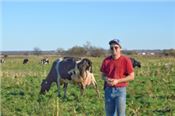|
Missouri Holstein Cow Produces Nearly 24 Gallons Of Milk Per Day

Dezi, a Lawrence County Holstein, churns
out 201 pounds of milk per day, almost three
times as much as the average Holstein.
Photo credit: Sarah Damrow
Owner ‘Grazes’ The Bar With Quality Forage
MOUNT VERNON, MO.
Missouri Holstein Dezi is a moo-ver and a milker. The Lawrence County cow outperforms most of her regional counterparts, producing just short of three times as much milk per day, says University of Missouri Extension dairy specialist Reagan Bluel.
Dezi, owned by farmer Karl Wilke, churns out 201 pounds of milk per day. That’s the equivalent of about 24 gallons-15 gallons more than the average Holstein.
The 200-pound-plus achievement through peak production is not uncommon in dairy states, but it is rare in Missouri’s Ozark region. “She’s a superstar,” says Bluel.
Dezi’s efforts earned her nomination as the Missouri Holstein Association Cow of the Year. The winner was named at the Heart of America Expo, Jan. 19-21 in Springfield. More than 500 producers from 15 states plan to attend.
Bluel says Wilke uses solid dairy management practices to achieve outstanding herd performance.
Wilke is “graze-ing the bar” for other dairy producers by growing and feeding quality forage. “They do a phenomenal job of putting up great forage,” Bluel says.
Wilke feeds Dezi and the rest of the herd corn silage and high-moisture cereal rye bales - 60 percent moisture – and pastures the herd on cereal rye. There is no alfalfa in the Wilke herd diet. Wilke says he quit growing alfalfa after the 2012 drought and bought it for a few years when fertilizer prices increased. He saw some production loss but profits increased.
Wilke also uses the services the Dairy Herd Improvement Association testing and record-keeping. Bluel also points out that Wilke studies and then amends management based on the results of DHIA tests and records.
Dezi was born and AI-bred on the Wilke farm. As a first-lactation heifer, she showed promise, Bluel says. The 5-year-old is being flushed to maintain multiple offspring.
A bred heifer is scheduled to freshen this fall to carry on the cow family name. Wilke is eager to see if she will shine among her peers in the 165-head herd. He hopes her genetics will carry on to her progeny. Third-party testing confirms her milk for protein and butterfat quality.
Dezi feeds on partial mixed ration and is turned out to graze on rye. Part of her superb performance may be attributed to rains in the fall of 2015 that created optimum lush pastures.
Advantages of feeding a partial mixed ration (PMR) include more uniformity in nutrients reaching the cow and therefore less disruption of rumen function, Bluel says. Supplementation allows for an improved control of dry matter intake and reduced rumen digestive problems. “When supplementing pasture with PMR, the rumen is prepped for dietary changes to continue to support lactation even when the pasture gets short,” she says.
Research at Penn State University shows that grazing cows supplemented with a PMR had higher milk fat and protein, better body condition and produced 8 pounds more milk per day than those not fed a PMR.
Wilke and his parents moved their dairy operation to Missouri from Wisconsin in 1979. Missouri's milder climate appealed to them. Wilke family members have been dairy farmers since coming to the United States from Germany in the 1860s.
Wilke family members are strong supporters of MU Extension education. Karl serves as president of the Lawrence County Extension Council. His family donated some of the foundation heifers in the University of Missouri grazing herd.
Wilke believes in passing along his dairy knowledge to MU Extension 4-H members and others. He provides scholarships for 4-H camp and offers to host dairy judging clinics at his farm. Wilke helps 4-H dairy judging teams prepare for competitions. “He is someone who always asks how he can help others and our activities,” says 4-H youth development specialist Karla Deaver.
Wilke, Bluel and others interested in the southwestern Missouri bovine phenomenon plan to follow Dezi and her offspring.
“You pour your heart and soul into your passion for milk production,” Bluel says. “Day in and day out, there is never a dull moment. Every once in a while, there is the unexpected in the herd. The outlier cow that makes you proud. Those are the moments-those are the cows-that keep you passionate about your love of making milk.” ∆

Karl Wilke, a fifth-generation dairy farmer, owns Dezi, a Holstein
nominated for the Cow of the Year award.
Photo credit: Reagan Bluel
|
|